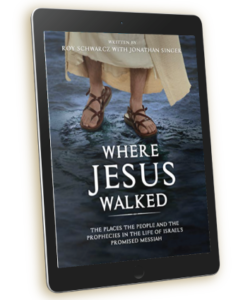Revelation 5:5-7 Because his tears were inappropriate, one of the elders told John to stop weeping. He pointed to Jesus, the Lion that is from the tribe of Judah. That title comes from Jacob’s blessing on Judah given in Genesis 49:8-10.
It is from this description that the Jewish people reject the idea that Yeshua is the Messiah, they expected the Messiah to be powerful to liberate them from Rome. Jesus had no political aspirations (John 6:15;18:36), nor did He use His powers against the Rome. Instead, He offered a spiritual kingdom.
However the prophets foretold that He would come as both the Lion and the Lamb and a day is coming when the wrath of the Lamb shall come. That day begins to unfold in Revelation 5 .
Yeshua is also described as the Root or descendant of David (Revelation 22:16; Jeremiah 23:5-6;33:15-17). That messianic title derives from Isaiah 11:1,10: As the genealogies of Matthew 1 and Luke 3 reveal, Jesus was a descendant of David both on His father’s and on His mother’s side.
The term “Son of David” is a messianic title used frequently in the Gospels (Matthew 9:27; 12:23; 15:22; 20:30-31; 21:9,15; 22:4; Mark 12:35).
Jesus is the One worthy to take the scroll because of who He is, the rightful King from David’s; what He is, the Lion from Judah’s tribe with the power to destroy His enemies; and also because of what He has done, at the cross. There He defeated sin (Romans 8:3), death (Hebrews 2:14-15), and hell (Colossians 2:15; 1 Peter 3:19).
Instead of the seeing the Lion of the Tribe of Judah, John saw a Lamb. The picture John has comes from the Passover, when Jewish families were required to keep the sacrificial lamb as a household pet for four days before sacrificing it (Exodus 12:3-6). That lamb foreshadowed what Isaiah spoke of (Isaiah 53:7). In the New Testament outside of Revelation, He is only called a lamb four times (John 1:29,36; Acts 8:32;1 Peter 1:19).
But in Revelation He appears as the Lamb thirty-one times. This lamb was standing and looking as if He had been slain. The scars His wounds were clearly visible; yet He was alive. The Lamb had seven horns which speak of strength and power (1 Samuel 2:1,10; 2 Samuel 22:3; Psalm 18:2; 75:10; 89:17, 24; Jeremiah 48:25; Micah 4:13).
Seven, the number of perfection completeness, symbolizes the Lamb’s complete, absolute power. The Lamb had seven eyes, denoting perfect omniscience and complete understanding and knowledge. Those eyes, represented the seven Spirits of God, sent out into all the earth. As discussed earlier in Revelation 1:4, 4:5, the phrase seven Spirits of God describes the Holy Spirit in all His fullness. Revelation 5:7 records the final act in the heavenly scene.
Everything John has been describing since this vision began in 4:1 had been building toward this moment. The ultimate goal of redemption is about to be seen; paradise will be regained. This is the same scene described by Daniel in Daniel 7:13-14 , although Daniel does not mention the scroll.


